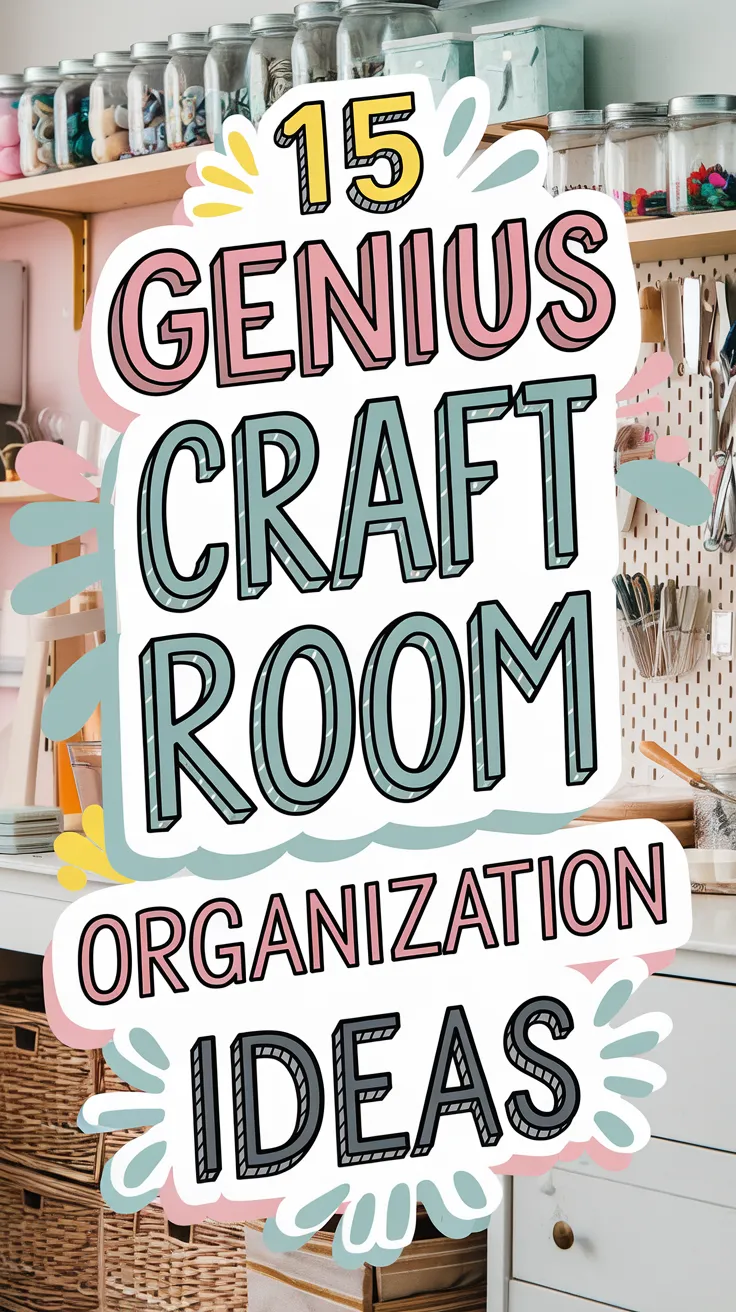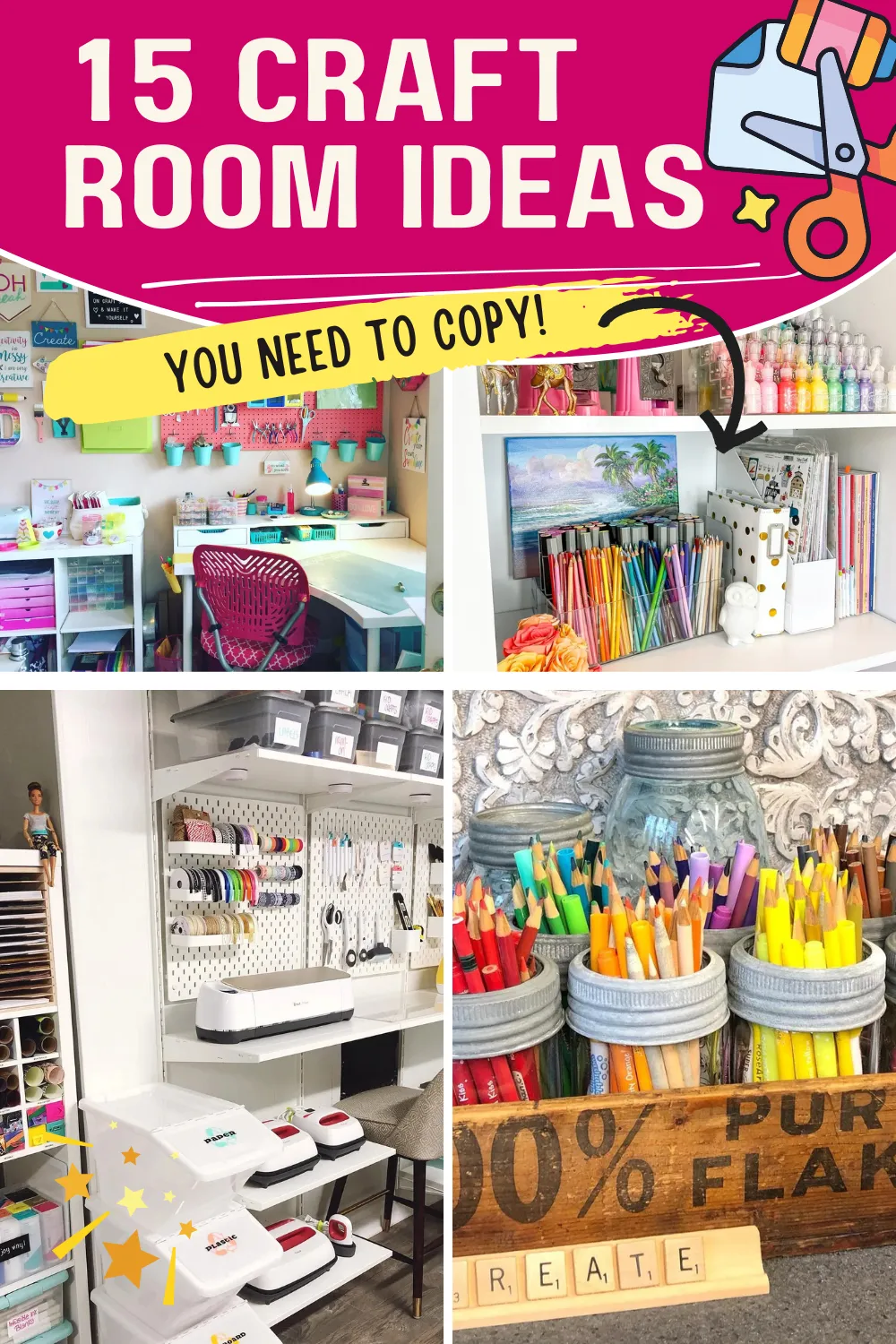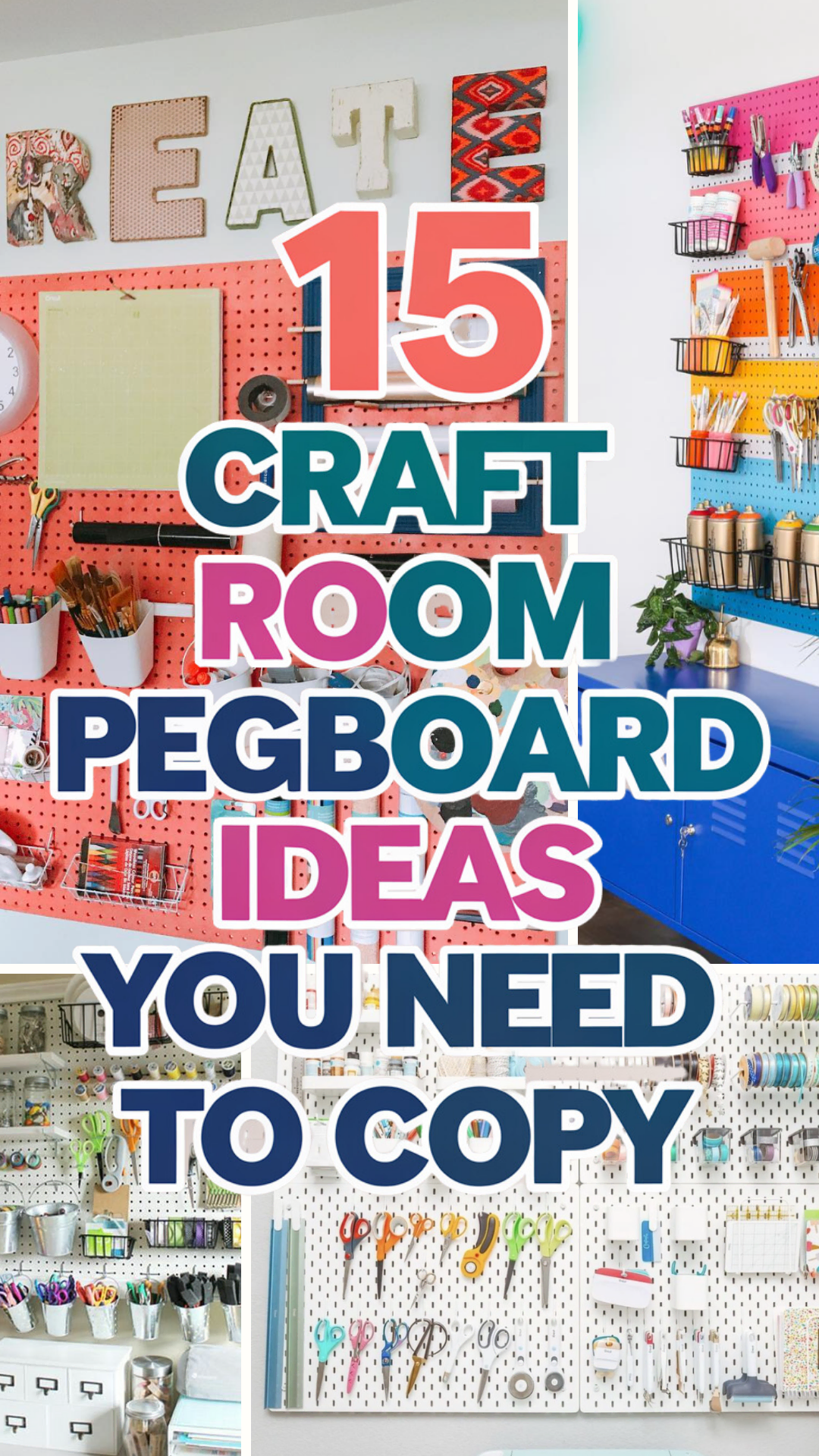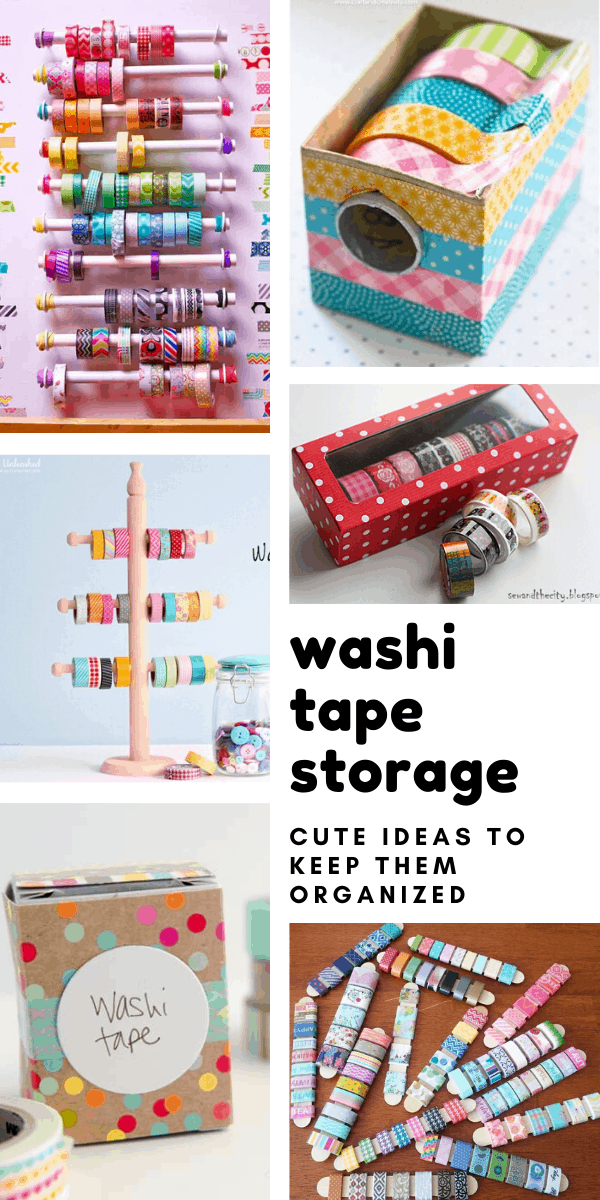This post may contain affiliate links. As an Amazon Associate I earn from qualifying purchases. If you click and buy, I may receive a small commission at no extra cost to you. Read our Disclosure Policy
Oh, the chaos of crafting in a tiny room—I’ve been there! One minute, you’re all excited to start a project, and the next, you’re knee-deep in a pile of supplies, wondering where your glue gun wandered off to. It’s like the craft supplies are playing hide-and-seek! I once tore my room apart looking for my scissors, only to find them right on my desk buried under a stack of paper! Sound familiar? Don’t worry—you’re not alone! Let’s tackle that crafty chaos together with some easy tips to get your space in order. Trust me, a little organization goes a long way, even in the tiniest of rooms. Let’s get those craft supplies working for you, not against you!
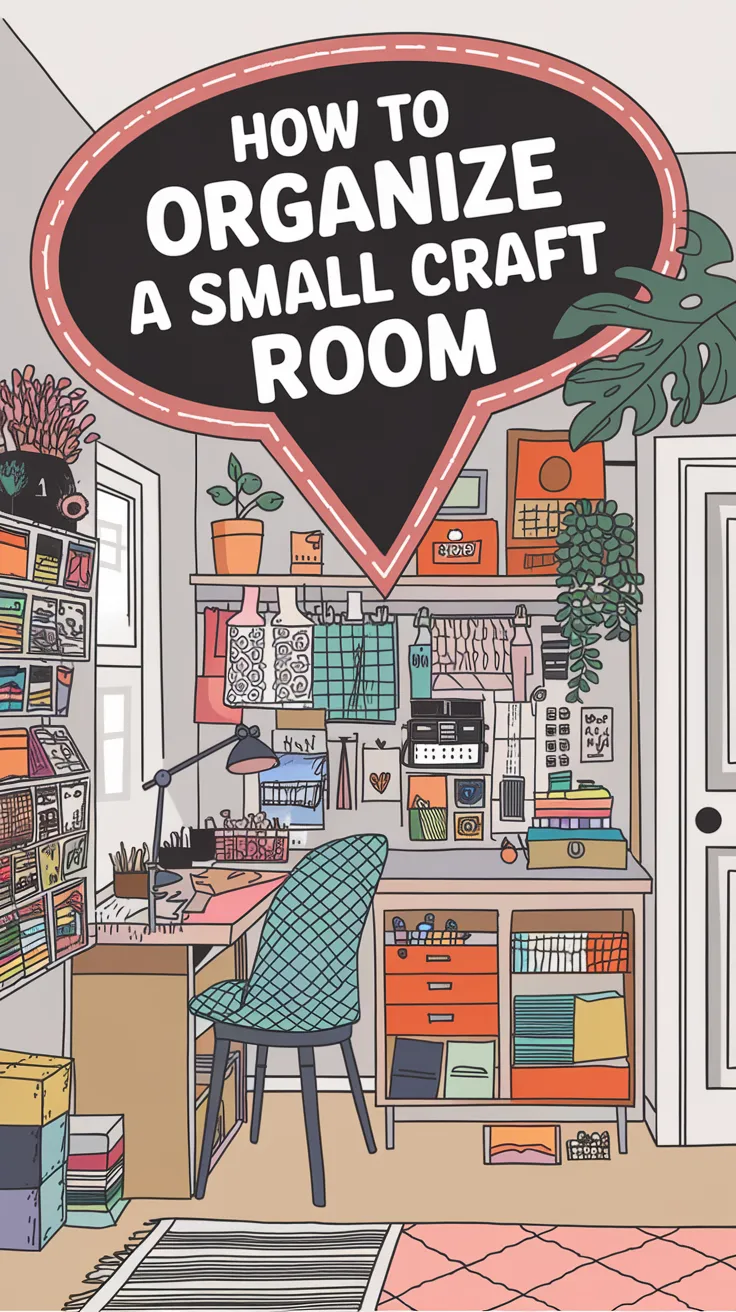
Assess Your Space and Needs
Before we start turning your craft room into an organized oasis, let’s pause and take a good look at what you’re working with. Trust me, a little prep here will save you a ton of frustration later. Think of this step as getting to know your space and supplies, so everything has its rightful place.
1. Take Inventory
Start by pulling out all your supplies and laying them out. Yep, all of it—it might look like a craft explosion at first, but this is key!
- Ask yourself: What do you have? Go through everything—paints, fabrics, markers, paper, tools, you name it.
- Be honest about what you actually use. If there’s glitter glue from 2010 that hasn’t seen the light of day, it might be time to part ways.
- Group similar items together: sewing materials, scrapbooking supplies, painting tools, etc. This will help you see how much space each category needs.
Pro Tip: Use this opportunity to toss out dried-up paints, scraps of paper you’ll never use, or that fabric you’ve been holding onto but secretly hate. Decluttering now makes organizing so much easier!
2. Understand Your Crafting Habits
Your craft room should work for you, not the other way around. Take a moment to think about the type of crafting you actually do.
- Are you a sewer with spools of thread and fabric scraps galore? You’ll need easy access to your sewing machine and a space to cut fabric.
- Love painting or drawing? A well-lit workstation with easy access to brushes, paints, and canvases will be a must.
- Into scrapbooking or card-making? Think about how you’ll store paper, stamps, and embellishments without them getting crushed or lost.
By focusing on your favorite crafting activities, you can prioritize the space and storage for those supplies. And hey, if you’re someone who dabbles in multiple crafts, that’s okay too! The goal is to keep your most-used items front and center, while less-used supplies can be stored out of the way.
3. Map Out Your Space
Once you’ve sorted through your supplies, take a good look at your craft room. Is it a tiny corner, a closet, or an entire room? No matter the size, you can make it work.
- Measure your space: Grab a tape measure and jot down the dimensions. This will come in handy when choosing storage solutions.
- Identify your storage spots: Look at the walls, corners, and even the back of the door for potential storage. Every inch matters in a small space.
Pro Tip: Sketch out a quick layout of your craft room and imagine (oops!) think about where each type of supply could live. Sewing materials here, paint supplies there—it doesn’t need to be perfect, just enough to give you a sense of how to make the most of your space.
Once you’ve taken stock of your supplies, figured out what crafting activities you need space for, and mapped out the room, you’re ready for the fun part: organizing! Remember, a little planning goes a long way when it comes to making your small craft room feel functional and fabulous.
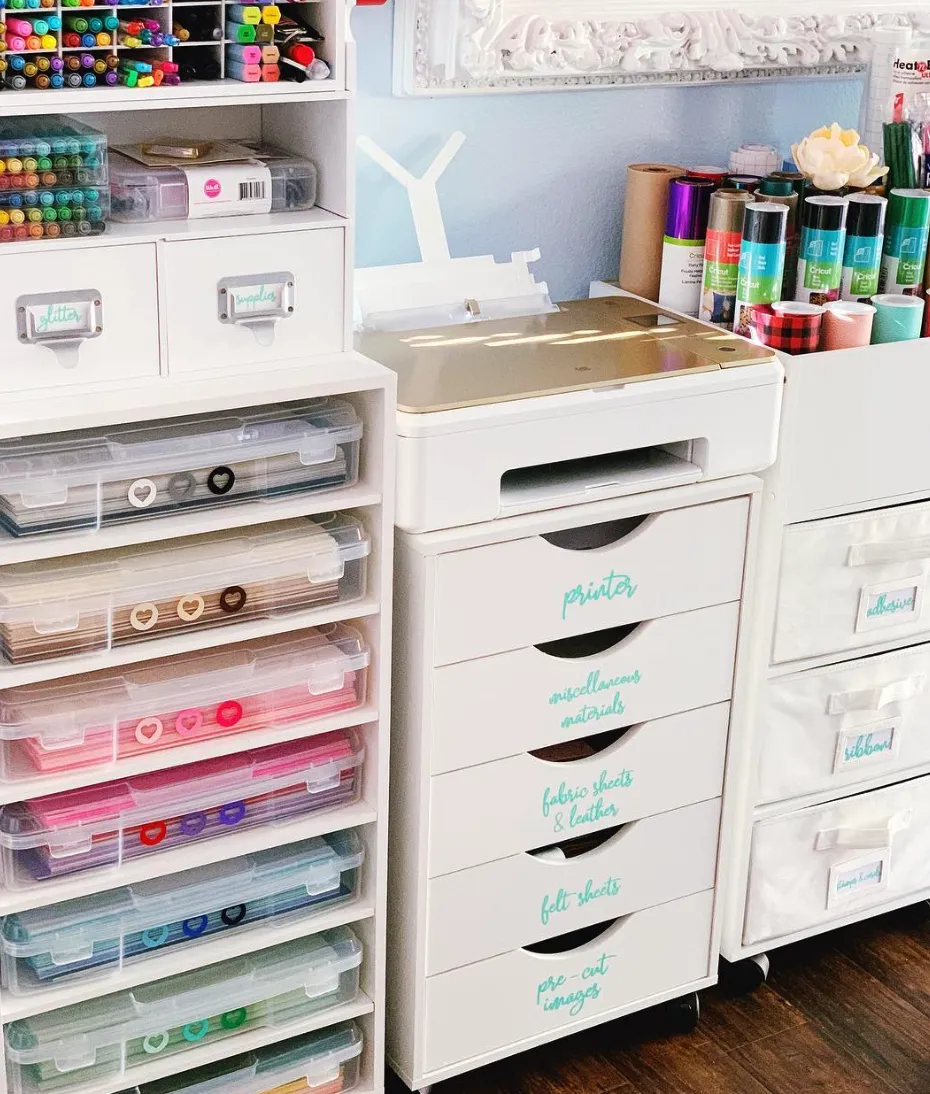
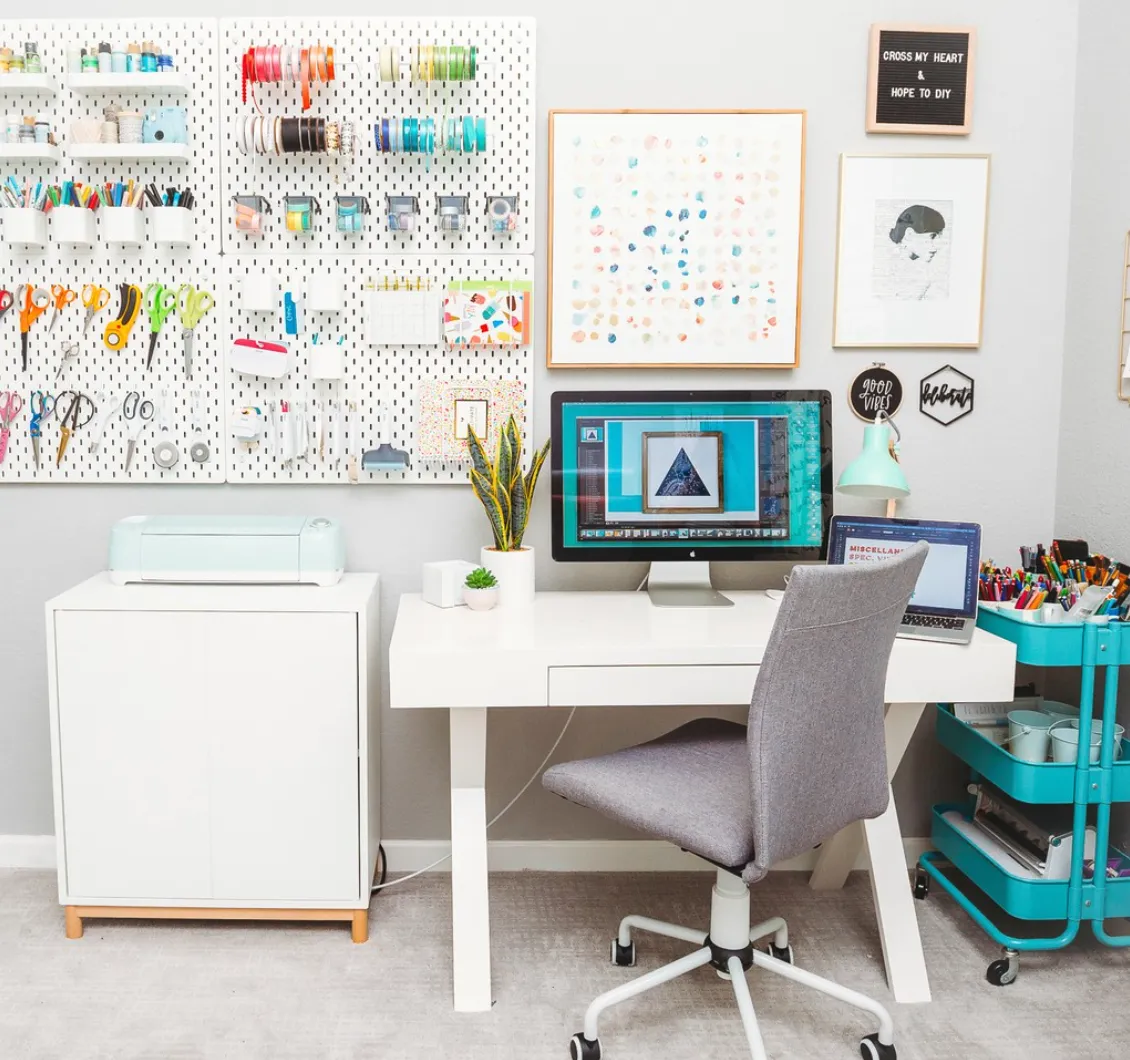
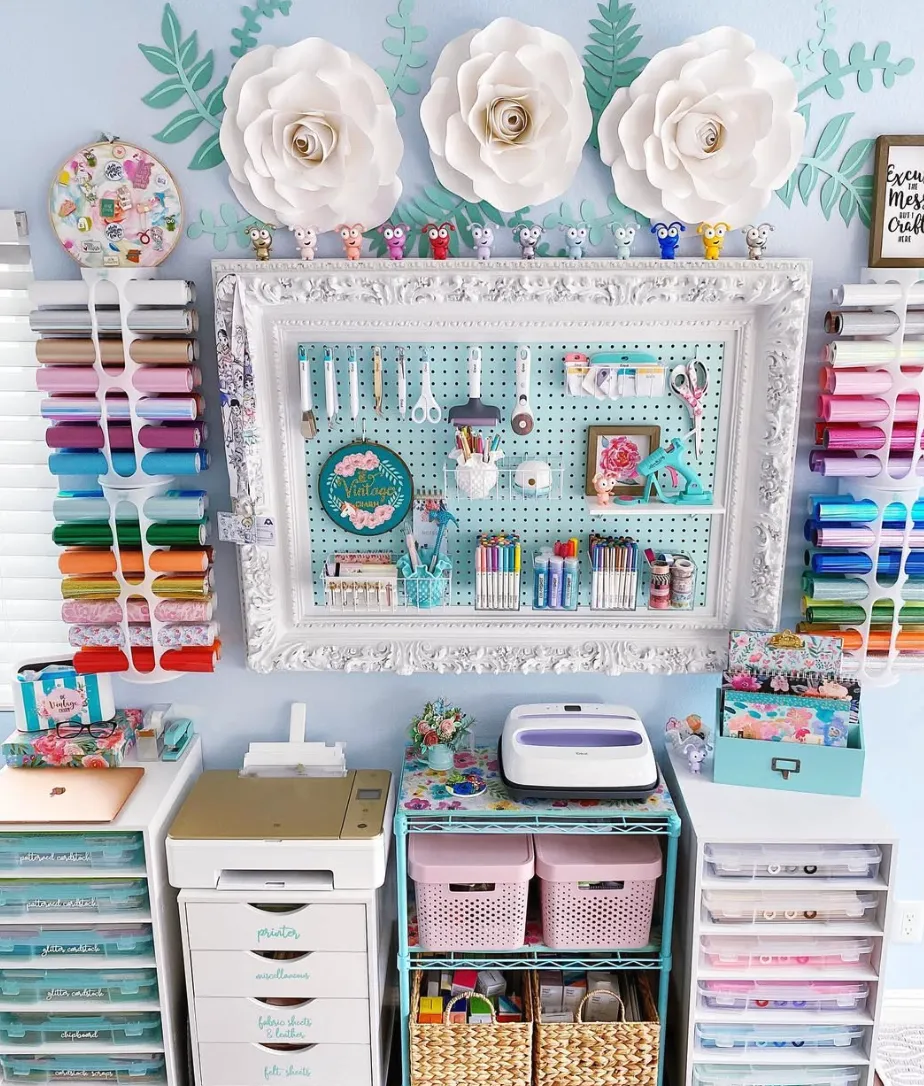
Need some more Craft Room Inspo? Check out these Craft Room Ideas you’ll want to copy!
Decluttering Tips for Crafters
I know you’re all excited to jump into the organizing bit (or is it just me that loves shopping for storage stuff??) but before we do that we need to do a some decluttering. I know parting with craft supplies can be hard—what if you need that random roll of glitter tape someday? But let’s be real, a cluttered space makes it harder to focus on your projects and enjoy your creative time. So, let’s tackle the mess head-on with these simple steps.
1. Sort Supplies
The first step is to sort everything you own into three piles: keep, donate, and toss.
- Keep: These are the supplies you actually use and love. If it sparks joy and serves a purpose, it stays.
- Donate: If you’ve got supplies in good condition that you haven’t used in ages (and probably never will), pass them along to someone who can. More on this below!
- Toss: Broken tools, dried-up paints, or that glitter glue from a decade ago that’s turned into a solid block—into the bin they go!
Pro Tip: If you’re struggling to decide, ask yourself: Have I used this in the last year? If not, it’s probably safe to say goodbye.
2. Donate Responsibly
One crafter’s cast-offs are another’s treasure. Donating your unused supplies is a great way to declutter while giving back.
- Schools: Teachers love getting craft supplies for art projects. Think markers, paper, glue sticks, and scissors.
- Community Centers: Many centers run crafting programs and welcome donations like yarn, fabric, and tools.
- Nonprofits or Shelters: Some charities run art therapy programs or creative workshops and are always in need of materials.
- Friends or Craft Groups: If you know a fellow crafter who would love that fabric or extra paints, pass them along.
Donating is a win-win—you free up space, and your supplies get a second life with someone who’ll actually use them.
3. Limit Duplicates
Raise your hand if you’ve ever bought a new craft supply because you couldn’t find the one you know you already own. (Guilty!) But now’s the time to get real about duplicates.
- Scissors: How many pairs do you really need? Keep your favorites and donate or toss the rest.
- Pens and Markers: Test them all and toss the ones that are dried out. Keep only what you actually use.
- Scraps and Extras: Fabric scraps, tiny pieces of paper, or leftover beads can pile up fast. If they don’t have an obvious use, let them go.
Pro Tip: Once you’ve decluttered, store duplicates of essentials (like scissors or glue sticks) in one clearly labeled spot. That way, you always know where to find them.
4. Make Decluttering a Habit
Decluttering doesn’t have to be a one-time event. Make it part of your crafting routine!
- Do a quick tidy-up after every project—put supplies back where they belong, and toss anything you don’t need.
- Set aside time every few months to go through your stash and re-evaluate what you’re using.
By keeping the clutter in check, you’ll create a space that feels calm, inspiring, and ready for your next project.
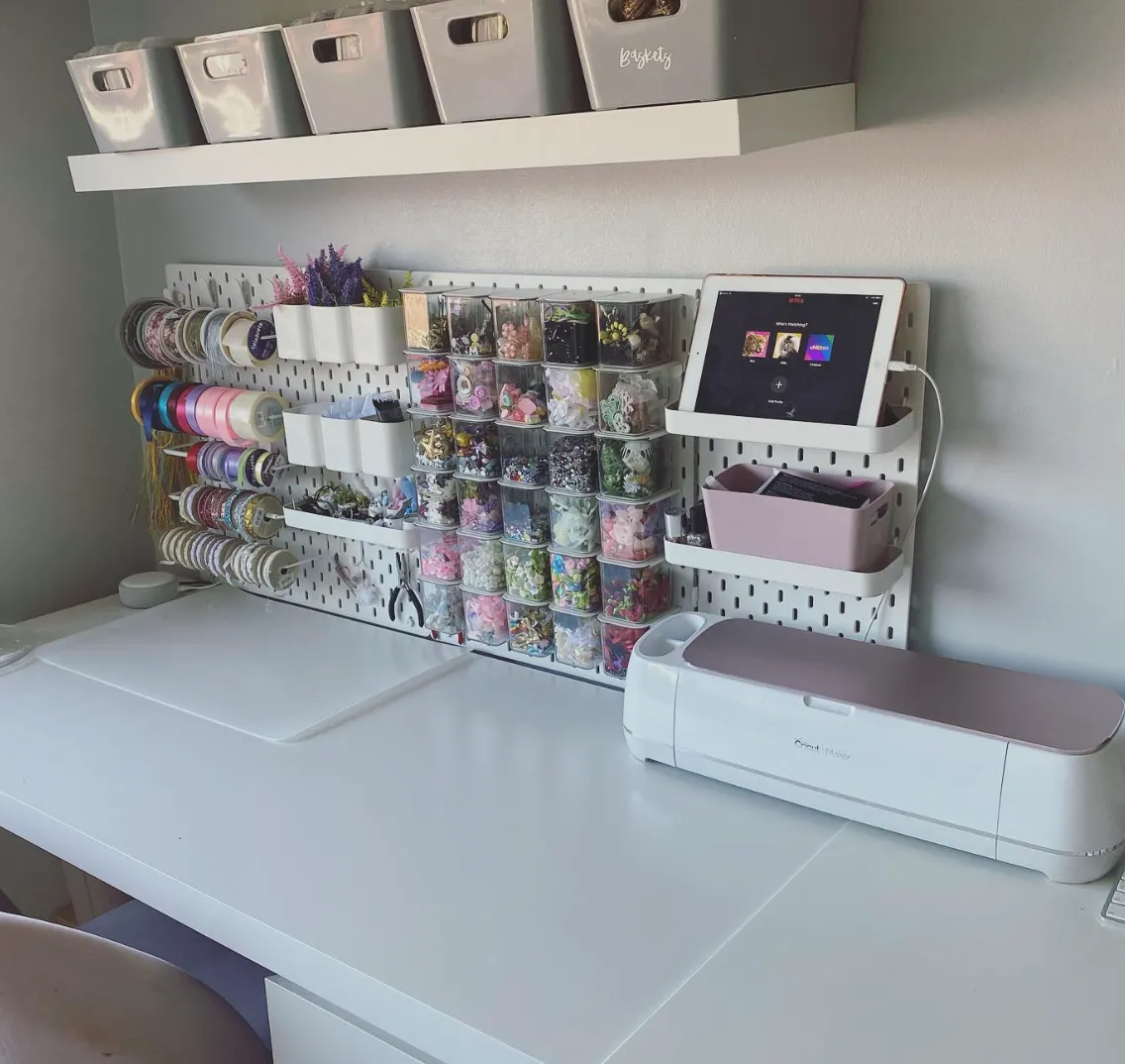
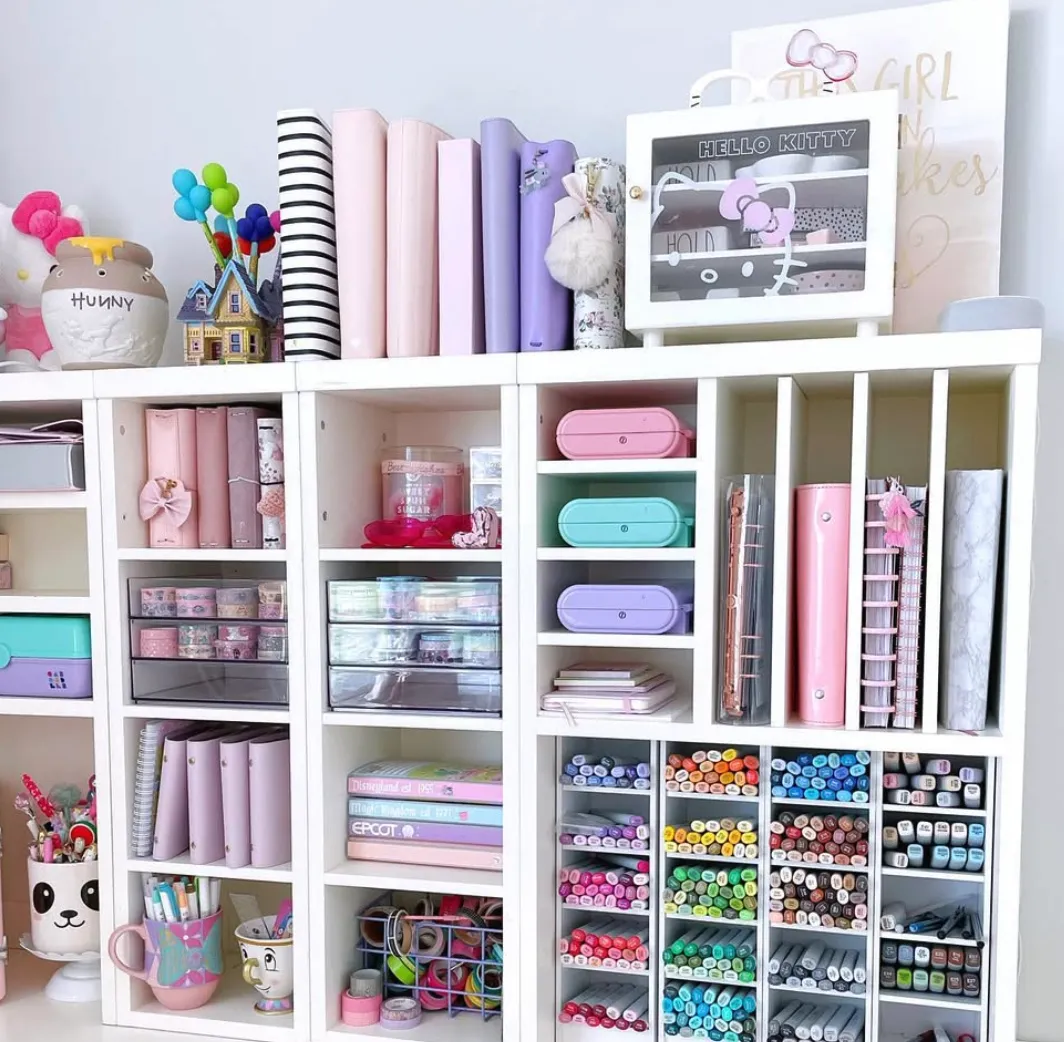
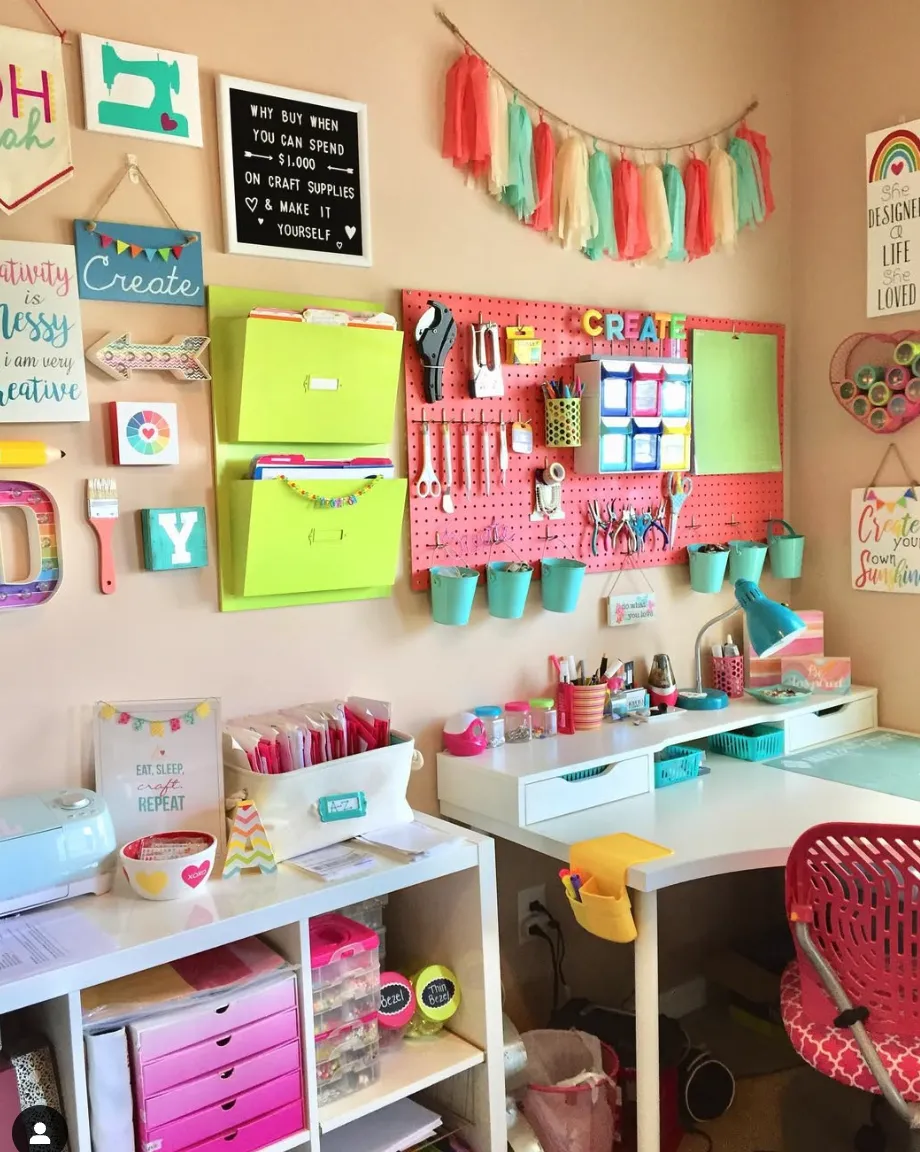
Clever Storage Solutions for Small Spaces
Here’s where the magic happens! These storage hacks are designed to make even the tiniest craft room feel spacious and efficient. With the right strategies, you’ll be amazed at how much you can organize without feeling cramped.
1. Go Vertical
When floor space is at a premium, the walls become your best friend.
- Shelving: Install floating shelves or wall-mounted cabinets to store boxes, jars, or decorative baskets. Arrange items by frequency of use—keep everyday tools at eye level and seasonal supplies higher up.
- Pegboards: These customizable wonders are perfect for keeping tools like scissors, rulers, and washi tape within reach. Add hooks, baskets, or small shelves to hold supplies of various sizes. Bonus: You can paint a pegboard to match your decor for a personal touch.
- Hanging Storage: Attach hooks or rails with hanging buckets for quick access to pens, brushes, or small tools.
2. Use Multi-Purpose Furniture
Furniture that serves double duty is essential for a small craft room.
- Look for desks with built-in drawers, cubbies, or shelves. Some even come with foldable tops to maximize space.
- A small cabinet or bookshelf with a fold-out table can transform into a crafting station when needed.
- Storage ottomans can double as seating while hiding less-used supplies like yarn or fabric scraps.
3. Clear Bins and Labels
Visibility is key when organizing small items.
- Use stackable, clear bins to store beads, buttons, and embellishments. This keeps everything dust-free and easy to find at a glance.
- Label Everything: Add cute, handwritten, or printable labels to avoid rummaging through containers. Pro Tip: Color-code bins by category (e.g., blue for sewing, green for painting) for quick identification.
4. Over-the-Door Organizers
The back of your door is often overlooked but is prime real estate for storage.
- Hang a pocket organizer to store small tools, spools of ribbon, or glue sticks.
- Use over-the-door hooks to hang tote bags filled with larger supplies like fabric or paper rolls.
- Consider a hanging shoe organizer with clear pockets—perfect for storing brushes, markers, or tape rolls.
5. Magnetic Strips
These are small but mighty space savers, especially for tools.
- Attach a magnetic strip to the wall or side of a desk to hold metal tools like scissors, tweezers, or needles.
- For extra versatility, consider a magnetic board paired with magnetic tins to store small items like pins or thumbtacks.
6. Rolling Carts
Mobile storage is a game-changer for small craft rooms.
- Use a tiered rolling cart to store supplies you use frequently, like paints, brushes, or sewing materials. Roll it to your workspace when needed and tuck it away when not in use.
- Consider grouping supplies by project type (e.g., scrapbooking on one tier, painting on another) to keep things organized.
- Add small organizers or cups to the cart for extra compartments, ensuring no space goes unused.
7. Bonus Ideas
- Under-Furniture Storage: Use shallow bins or trays to store supplies under desks or chairs.
- Wall-Mounted Fold-Down Table: For ultra-small spaces, a fold-down table attached to the wall can serve as a compact workspace.
- Lazy Susans: Place one inside a cabinet or on your desk for easy access to small supplies like adhesives or paints.
By mixing and matching these clever storage solutions, you’ll maximize every inch of your craft room while keeping it functional and inspiring. Small spaces? No problem! With these ideas, you’ll create a setup that’s both practical and pretty.
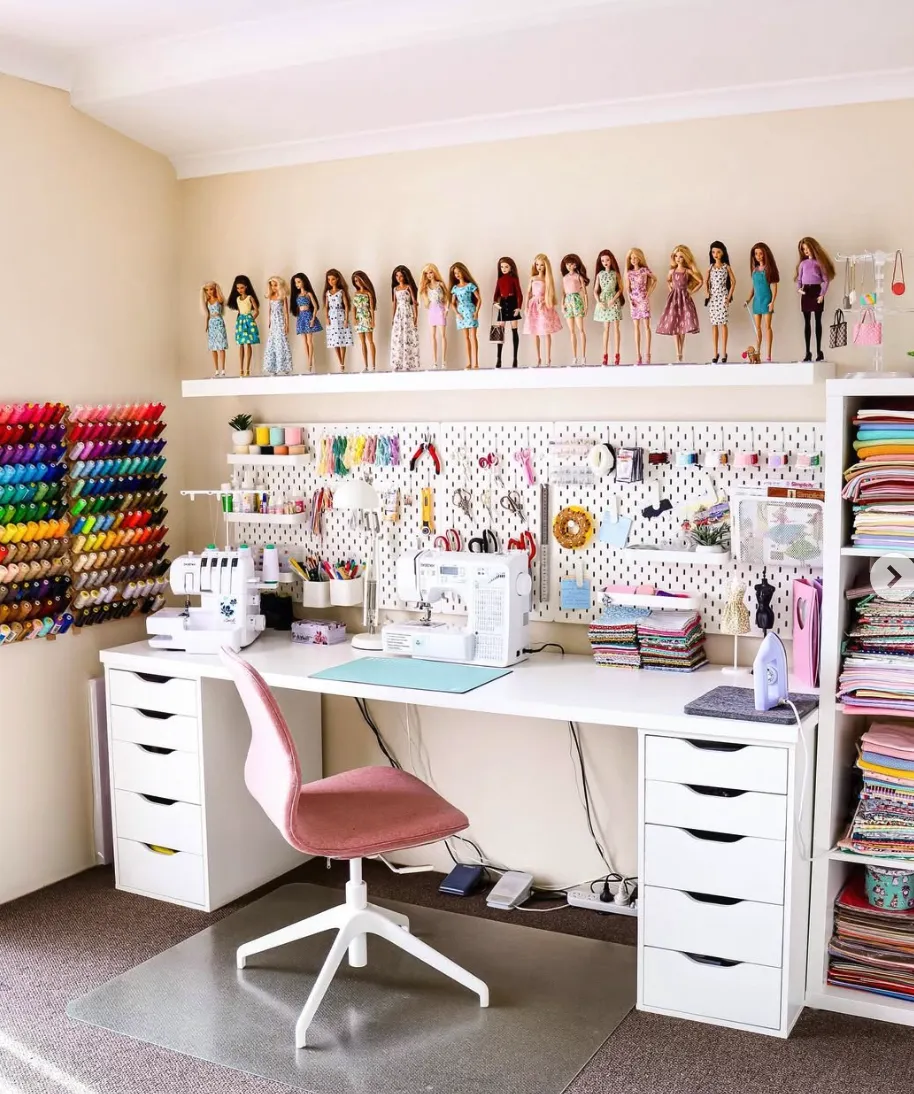
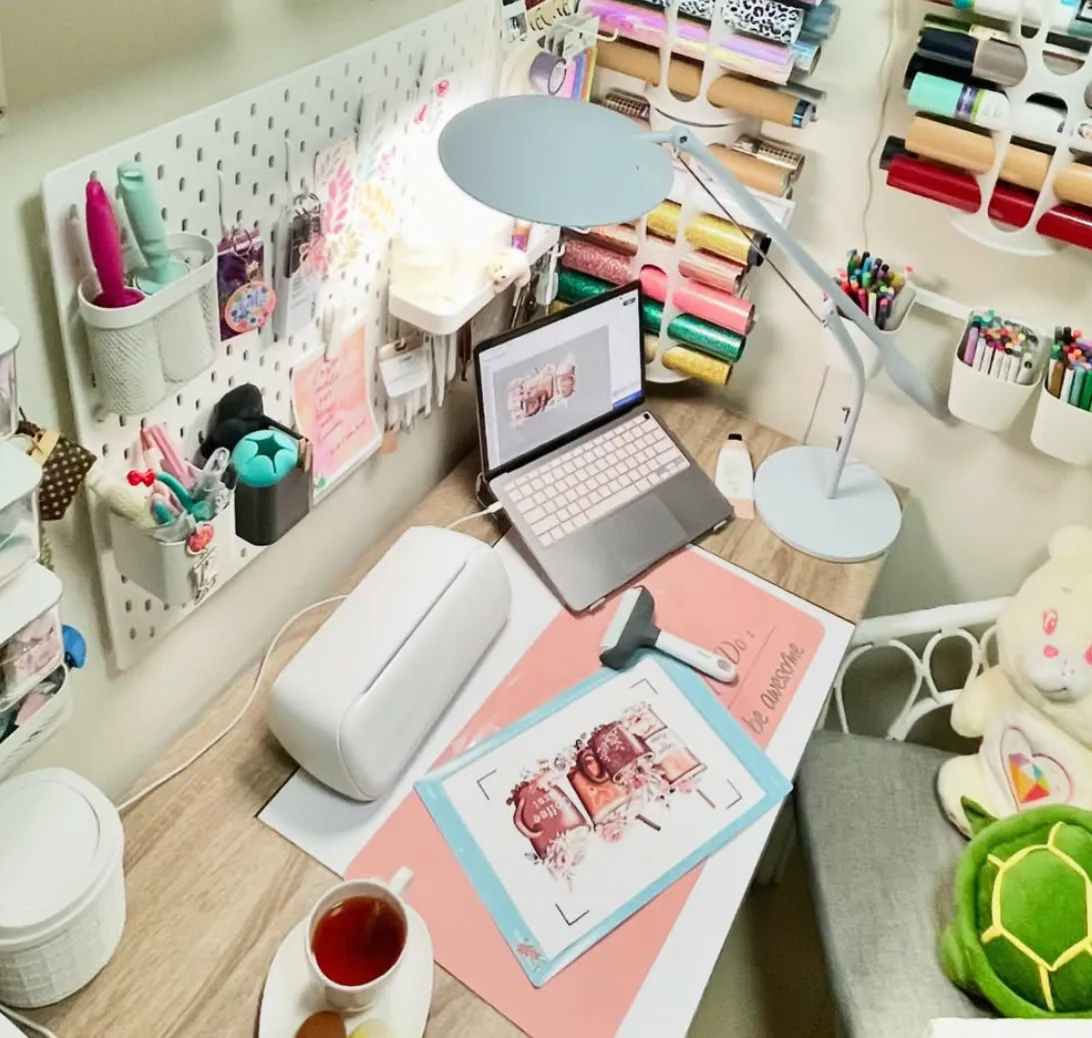
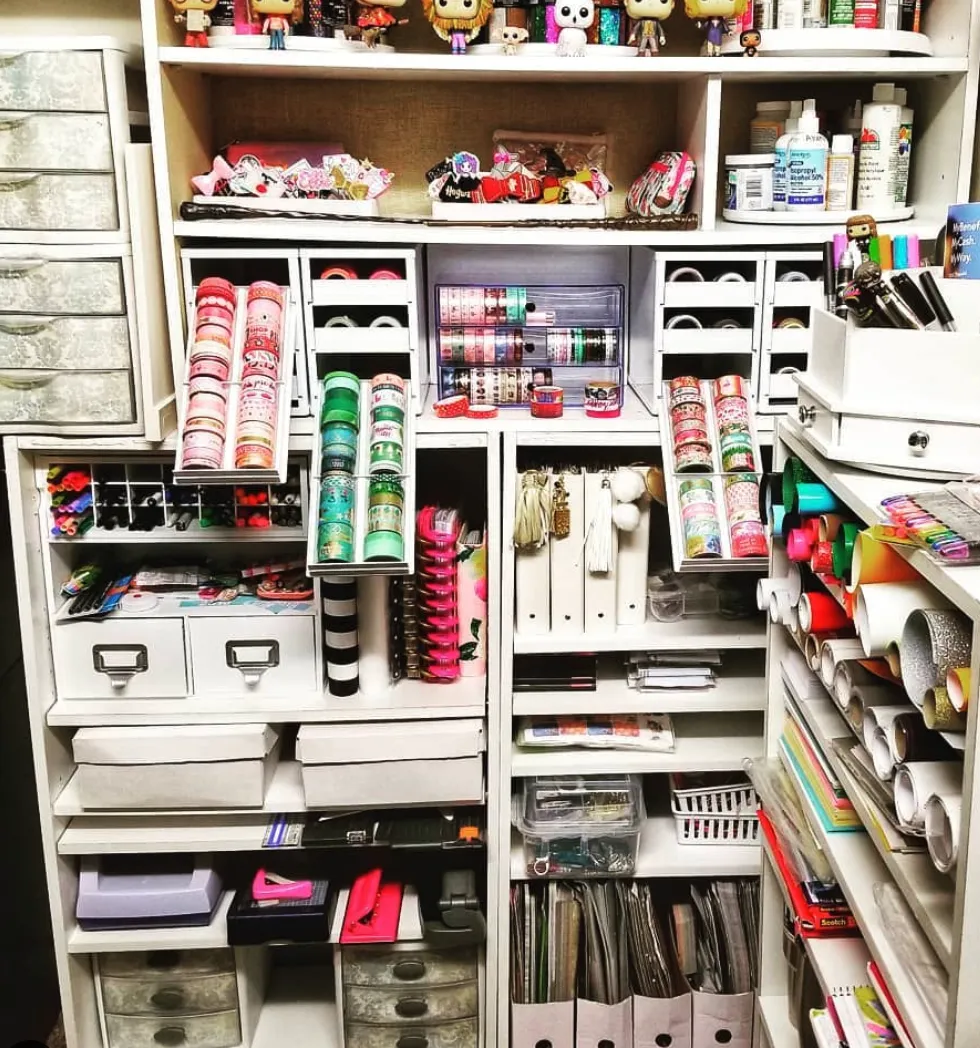
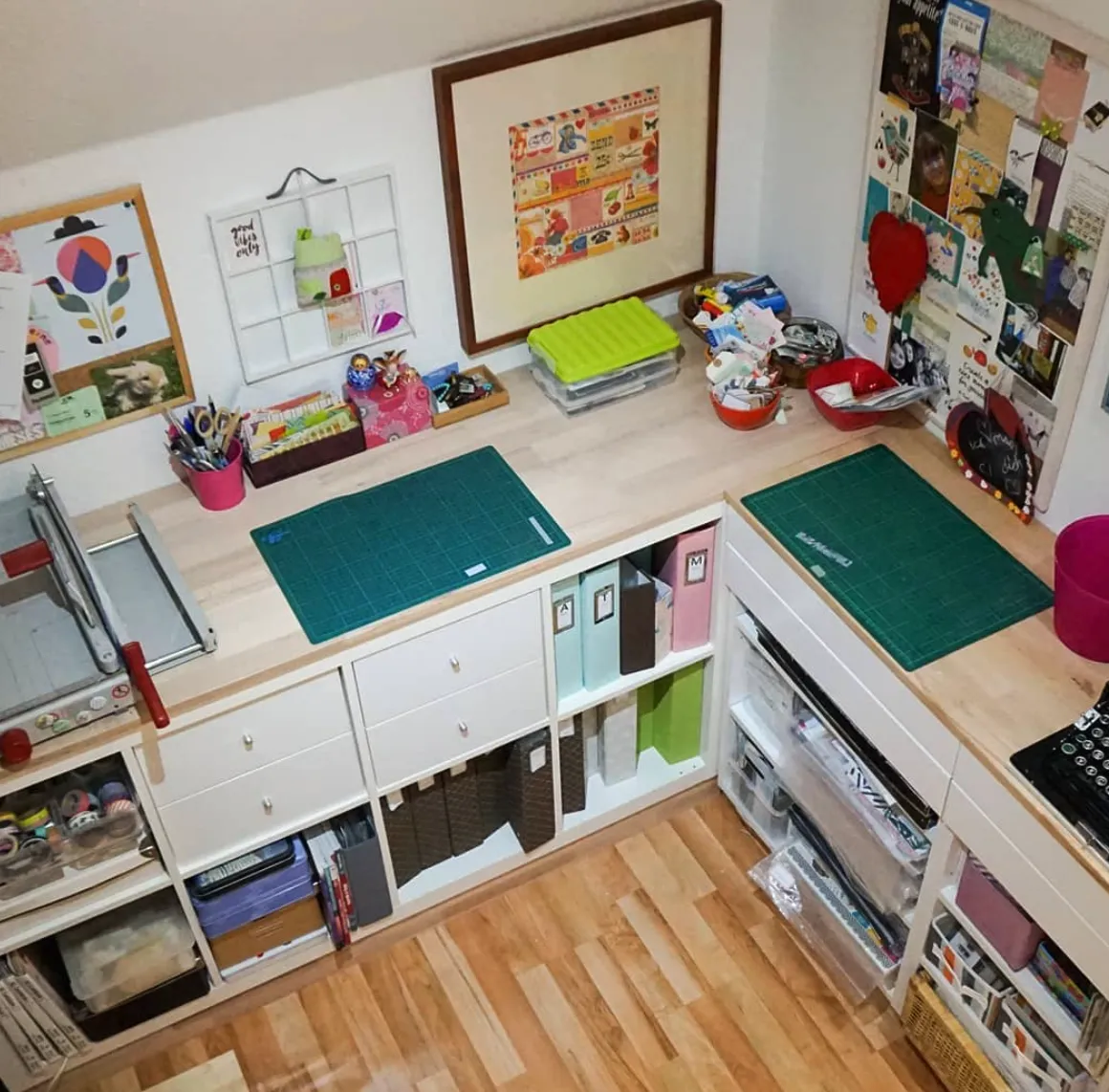
Setting Up Work Zones
Even in the smallest craft rooms, setting up distinct zones for different activities can make a huge difference. It’s all about creating an efficient flow, so you’re not constantly shifting things around or hunting for supplies. The best part? These zones can be as small as a corner of your desk or even portable! Here’s how to make it work:
1. Cutting Zone
Every crafter needs a dedicated spot for cutting materials, whether it’s fabric, paper, or patterns.
- What to Include: Cutting mats, rotary cutters, rulers, scissors, and measuring tape.
- How to Set It Up: Store tools in a small container or wall-mounted organizer near your cutting surface. Keep your cutting mat in a spot where it’s easy to grab when needed.
- Pro Tip: If your table is limited, a foldable cutting mat can be a game-changer—it’s compact when stored but big enough to handle your projects when in use.
2. Sewing Zone
For those who sew, a sewing zone is essential. Keeping everything organized here can make projects so much smoother.
- What to Include: Your sewing machine, threads, needles, bobbins, fabric, and pins.
- How to Set It Up: Arrange your machine on a sturdy table with a nearby drawer or small organizer for supplies. Use a pegboard or wall hooks to hang threads and bobbins for easy access.
- Pro Tip: If space is tight, store your sewing machine on a rolling cart so you can tuck it away when not in use.
3. Painting Zone
If painting or drawing is your thing, a dedicated zone keeps your creative process mess-free (or at least mess-contained!).
- What to Include: Paints, brushes, palettes, canvas, and water jars.
- How to Set It Up: Use trays, baskets, or small bins to organize paints and brushes. Keep a rag or paper towels handy for quick clean-ups.
- Pro Tip: A tabletop easel can help save desk space while keeping your artwork upright as you paint.
4. Paper Crafting Zone
For scrapbookers, card makers, or paper crafters, this zone is a must.
- What to Include: Paper, stamps, punches, adhesives, and embellishments.
- How to Set It Up: Use stacking bins or drawers to organize paper by color or pattern. Keep smaller items like stamps and stickers in labeled boxes or trays.
- Pro Tip: Invest in a paper trimmer with a built-in storage area for your most-used tools.
5. Portable Workstations for Tight Spaces
If your craft room is really small or you’re working in a shared space, portable zones are a lifesaver.
- Trays or Caddies: Organize supplies for specific crafts (like painting or sewing) into portable trays or caddies. These can easily move to your kitchen table or a larger surface when you’re ready to work.
- Rolling Carts: Set up a mobile workstation by grouping supplies for one activity on a rolling cart. You can roll it to your work area and store it out of sight when you’re done.
- Foldable Surfaces: Use a foldable table or drop-leaf desk that can expand when needed and collapse to save space.
By dividing your space into functional zones, you’ll save time, reduce frustration, and make your crafting experience way more enjoyable. Whether you’re sewing, painting, or scrapbooking, having everything at your fingertips is a game-changer. Even in the tiniest craft rooms, these work zones will keep things running smoothly!
Lighting and Comfort Tips
Let’s talk about two things that can make or break your crafting experience: lighting and comfort. After all, nobody wants to strain their eyes trying to thread a needle or end up with a sore back after hours of creativity. With a few thoughtful tweaks, you can make your small craft space not only functional but also comfortable and inviting.
1. Good Lighting is Non-Negotiable
Crafting requires precision, whether you’re sewing, painting, or scrapbooking, so proper lighting is a must.
- Space-Saving Options: For small rooms, clip-on lamps or LED strip lights are lifesavers. Attach them to shelves, desks, or even a nearby wall to keep your workspace bright without taking up valuable room.
- Task Lighting: Invest in an adjustable desk lamp with a daylight bulb for true-to-color lighting—essential for matching colors or working on detailed projects.
- Overhead Lighting: If possible, swap your room’s ceiling light for one with adjustable brightness or add a pendant light for better overall illumination.
- Portable Lights: Rechargeable, battery-operated lights are perfect for flexibility, especially if your craft room doubles as another space.
Pro Tip: Position your light source to minimize shadows. If you’re right-handed, place your lamp on the left side (and vice versa) for optimal visibility.
2. Comfort Matters (A Lot)
Crafting is supposed to be relaxing, not a pain in your back or neck! A few simple changes can make your space much more comfortable.
- A Comfy Chair: Choose an ergonomic chair that provides good support for your back and arms. If you’re working at a table or desk, make sure your chair height allows your arms to rest comfortably at a 90-degree angle.
- Padded Mats: If you stand while cutting fabric or working at a counter, invest in a cushioned anti-fatigue mat to reduce strain on your feet and legs.
- Stay Warm (or Cool): Keep a small fan or portable heater nearby to maintain a comfortable temperature in your space, especially if it’s in a basement or attic.
- Wrist Support: If you’re doing repetitive tasks like cutting or typing, consider adding a wrist rest to prevent strain.
3. Personalize Your Comfort
Little touches can make your craft room feel cozy and inspiring.
- Add a soft throw pillow to your chair or a small blanket for colder days.
- Play your favorite playlist or have an audiobook on in the background to make crafting feel even more enjoyable.
- Keep a mug warmer nearby for your coffee or tea—because we all know a warm drink is a crafter’s best friend!
A well-lit, comfortable craft room makes all the difference. With the right lighting and ergonomic touches, you’ll find yourself enjoying crafting even more—and maybe even staying a little longer to finish that project. Because when you’re comfy and can actually see what you’re working on, there’s no stopping your creativity!
Maintenance Hacks for Staying Organized
Keeping your craft room tidy doesn’t have to feel like a chore. The trick? Make organization part of your routine! A little effort here and there will save you from the dreaded “craft room explosion” that sneaks up after a few big projects. Here are some easy, practical hacks to keep your space in check:
1. A Quick Tidy-Up After Every Session
You know how your workspace looks after a crafting spree—scraps everywhere, tools scattered, and a random spool of thread rolling under the table. To avoid the chaos from piling up, commit to spending just 5-10 minutes cleaning up after each session.
- Put tools back in their designated spots.
- Gather leftover materials and return them to their bins or drawers.
- Wipe down your workspace (especially if you’ve been painting or gluing).
Pro Tip: Treat tidying up as part of your crafting ritual. Finish your session by resetting your space so it’s ready for your next creative adventure.
2. Keep a Trash Bin Within Arm’s Reach
Scraps and packaging can add up fast, and without a nearby trash bin, it’s easy for clutter to take over.
- Use a small trash can or recycling bin near your workstation for easy clean-up.
- If you work on multiple types of projects, consider separate bins for general waste and recyclable materials like paper or fabric scraps.
- For sewing projects, keep a mini thread catcher or a small container for fabric trimmings.
3. Label Everything
Labeling isn’t just for kids’ school supplies—it’s a game-changer for crafters!
- Use clear labels or cute tags to mark bins, drawers, and boxes. Think categories like “Paint Supplies,” “Fabric Scraps,” or “Sewing Tools.”
- If you’re feeling fancy, use a label maker to create neat, matching labels that make your space look extra organized.
- For clear containers, place labels on the front or lid so you can instantly see what’s inside.
4. Adopt a “One In, One Out” Rule
Craft supplies have a way of multiplying (hello, irresistible sales!), so it’s important to keep the clutter in check.
- For every new item you bring in, aim to get rid of something you no longer use.
- If your bins or shelves start feeling cramped, take a moment to reassess what’s really worth keeping.
5. Schedule a Monthly Declutter
Even with the best intentions, things can pile up over time. Set aside 15-30 minutes once a month to do a quick declutter.
- Sort through your supplies and pull out anything you no longer use.
- Reorganize bins or drawers if things have shifted out of place.
- Double-check labels to make sure everything is still in the right spot.
6. Use Visual Cues to Stay on Track
Make organization easier by keeping your system visually intuitive.
- Store your most-used items in clear containers or open bins so they’re easy to spot.
- Arrange supplies by color, type, or project for a visually pleasing and functional setup.
7. Have a Reset Day
If you’ve just finished a big project and your craft room looks like a tornado hit it, designate a “reset day.” Spend some time putting everything back where it belongs and refreshing your space.
With these simple maintenance habits, staying organized becomes second nature. Not only will your craft room look great, but you’ll save time and energy when diving into your next creative project. Because let’s be real—crafting is way more fun when you’re not digging through piles to find that one elusive tool!
Organizing a small craft room might feel overwhelming at first, but trust me—it’s worth it. Once everything has its place, you’ll spend less time searching for supplies and more time creating. Your craft room will go from chaotic to calming, becoming a space you actually enjoy spending time in.
Do you have a favorite organization tip or a go-to storage product? Share it in the comments! And if you found this post helpful, don’t forget to save it on Pinterest or share it with your fellow crafters.

